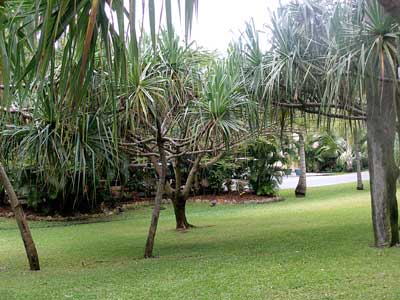Pandan leaves come from a small, single, sometimes multi-stemmed "Dr. Seuss" looking palm-like tree which grows in the sub and sub-tropical climates of Madagascar, Southeast Asia, and Oceania. It's intense green strap leaves are fragrant and used to flavor both sweet and savory foods in East-Asian culinary traditions, particularly, rice dishes.
The fruit of the larger pandan is eaten both cooked and raw. In India, an extract of the pandan flowers, called Kewra, is used to flavor beverages. Pandan is also used in curry dishes, in preserves, and flavors cakes and other desserts. In the islands of Oceania, the pandan is a culturally important resource providing not only food seasoning, but medicine, fiber for textiles, materials for the construction of shelters, is used as a dye, provides raw material for mats, and many other useful items.
Pandan is known by many names: screw pine or palm, fragrant plant/ 斑蘭 or (bān lán) in Mandarin, (su mwei ywe) in Myanmar, rampe in Sinagalese, (bai toei) in Thai, and lá dứa in Vietnamese.
Similar in flavor to jasmine rice-somewhat nutty-pandan has also been described as tasting like a “citrusy coconut” with a bright, grassy, and smooth sweetness. The fruit, which resembles a hard and spiky pine cone, is a drupe and has a grassy, vanilla flavor with a slight coconut finish. The long fibrous leaves are torn into long strips which are tied into knots so they may be easily retrieved after flavoring the dish in which they are cooked. The leaves are also pounded to break down the fibres and then minced to add to soups and stews. Pandan can be purchased in bundles of fresh leaves, dried, in syrup, paste or gel. Best when fresh, Pandan will impart a bright green shade to whatever it flavors.
